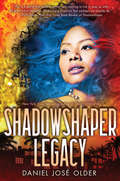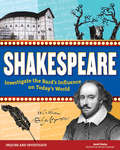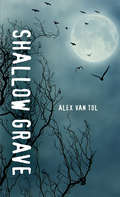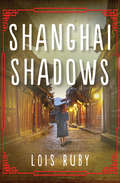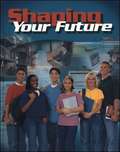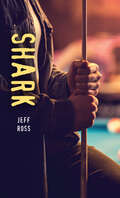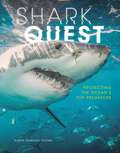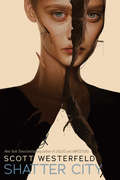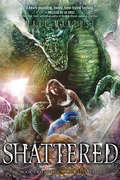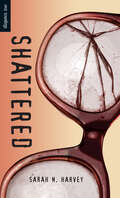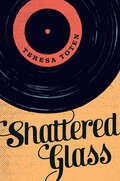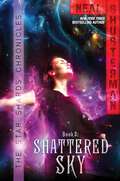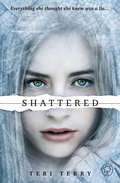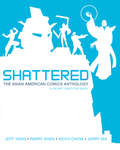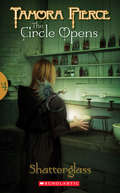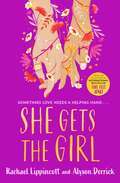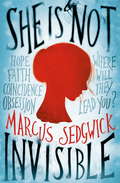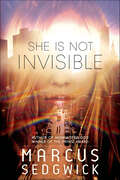- Table View
- List View
Shadowshaper (The Shadowshaper Cypher #1)
by Daniel José Older"Magnificent." -- Holly Black, New York Times Book ReviewCome to the crossroads, to the crossroads comeSierra Santiago planned an easy summer of making art and hanging with her friends. But then a corpse crashes the first party of the season. Her stroke-ridden grandfather starts apologizing over and over. And when the murals in her neighborhood begin to weep real tears . . . Well, something more sinister than the usual Brooklyn ruckus is going on.Where the powers converge and become oneWith the help of a fellow artist named Robbie, Sierra discovers shadowshaping, a thrilling magic that infuses ancestral spirits into paintings, music, and stories. But someone is killing the shadowshapers one by one -- and the killer believes Sierra is hiding their greatest secret. Now she must unravel her family's past, take down the killer in the present, and save the future of shadowshaping for herself and generations to come.Full of a joyful, defiant spirit and writing as luscious as a Brooklyn summer night, Shadowshaper introduces a fantasy heroine and magic unlike any you've ever seen before, and marks the YA debut of a brilliant new storyteller.
Shadowshaper Legacy (The Shadowshaper Cypher #3)
by Daniel José OlderThe epic conclusion to the acclaimed Shadowshaper Cypher trilogy!A house dividedSierra and the shadowshapers have been split apart. Juan, Anthony, and Izzy are in jail, anxiously waiting to find out what will become of them. Back in Brooklyn, the other shadowshapers have been getting threatening messages from whisper wraiths, catching strangely shaped figures stalking them, and fending off random spirits. A war is brewing among the houses, and the very magic of the shadowshapers is at stake.The fate of the worldsSierra is determined to protect her own in the coming conflict, even if that means keeping secrets from them. But a deal with Death by one of Sierra's ancestors has far-reaching consequences in the battles of the present, and as old fates tangle with new powers, Sierra will have to harness the Deck of Worlds and confront her family's past if she has any hope of saving the future and everyone she loves. Only doing so will mean following the magic to places the shadowshapers have never gone before . . . and may never return from.New York Times bestselling author Daniel Jose Older spins a masterful conclusion to his evocative and captivating Shadowshaper Cypher series in a finale of searing rebellion, the power of fate, and a magic unlike anything you've ever imagined.
Shadowspell (A Faeriewalker Novel)
by Jenna BlackOn top of spending most of her time in a bunkerlike safe house and having her dates hijacked by a formidable Fae bodyguard, Faeriewalker Dana Hathaway is in for some more bad news: the Erlking and his pack of murderous minions known as the Wild Hunt have descended upon Avalon. With his homicidal appetite and immortal powers, the Erlking has long been the nightmare of the Fae realm. A fragile treaty with the Faerie Queen, sealed with a mysterious spell, is the one thing that keeps him from hunting unchecked in Avalon, the only place on Earth where humans and Fae live together. Which means Dana's in trouble, since it's common knowledge that the Faerie Queen wants her – and her rare Faeriewalker powers – dead. The smoldering, sexy Erlking's got his sights set on Dana, but does he only seek to kill her, or does he have something much darker in mind?
Shakespeare
by Andi Diehn"Romeo, Romeo, wherefore art thou Romeo?” Teenagers have been sighing an approximation of these words for centuries, ever since William Shakespeare had Juliet utter them from her balcony in one of the most popular plays of all time, Romeo and Juliet. Tales of love, loss, rebellion, rivalry--before there was Twilight, Warm Bodies, and The Lion King, there was Shakespeare. The characters, language, imagery, and plot elements of many books and movies that appear on bookshelves and in cinemas today are directly influenced by the plays of the Bard. In Shakespeare: Investigate the Bard’s Influence on Today’s World, readers discover links between the books, movies, and music they listen to today and the words that were written and acted out more than 400 years ago. Readers deconstruct Shakespearean themes, imagery, language, and meaning by finding familiar ground on which to gain literary insight. Through hands-on projects such as coding a video game based on one of Shakespeare’s plays to rewriting a scene in the text language of emoji, readers find compelling avenues into the dramatic, sometimes intimidating language, leaving them well-equipped to tackle any major text in the academic years to come.
Shakespeare's Sonnets (First Avenue Classics ™)
by William ShakespeareAlong with writing comedic and dramatic plays, William Shakespeare was also a master poet. Using the sonnet structure (three quatrains and a final couplet composed in iambic pentameter), he composed 154 poems covering timeless themes of love, beauty, and mortality. The poems' subjects—the Fair Youth, the Dark Lady, and the Rival Poet—have become nearly as famous as the sonnets themselves. While not the first to write poems in sonnet form, Shakespeare's sonnets are considered the most influential examples of this style. The sonnets were first published in a 1609 quarto; this is an unabridged collection of all of Shakespeare's iconic sonnets, including Sonnet 18 ("Shall I compare thee to a summer's day?"), Sonnet 116 ("Let me not to the marriage of true minds/ Admit impediments"), and Sonnet 130 ("My mistress' eyes are nothing like the sun").
Shakespeare: Investigate the Bard's Influence on Today's World
by Samuel Carbaugh Andi Diehn"Romeo, Romeo, wherefore art thou Romeo?" Teenagers have been sighing an approximation of these words for centuries, ever since William Shakespeare had Juliet utter them from her balcony in one of the most popular plays of all time, Romeo and Juliet. Tales of love, loss, rebellion, rivalry-before there was Twilight, Warm Bodies, and The Lion King, there was Shakespeare. The characters, language, imagery, and plot elements of many books and movies that appear on bookshelves and in cinemas today are directly influenced by the plays of the Bard.In Shakespeare: Investigate the Bard's Influence on Today's World, readers discover links between the books, movies, and music they listen to today and the words that were written and acted out more than 400 years ago. Readers deconstruct Shakespearean themes, imagery, language, and meaning by finding familiar ground on which to gain literary insight. Through hands-on projects such as coding a video game based on one of Shakespeare's plays to rewriting a scene in the text language of emoji, readers find compelling avenues into the dramatic, sometimes intimidating language, leaving them well-equipped to tackle any major text in the academic years to come.
Shallow Grave (Orca Soundings)
by Alex Van TolWhen they're hauled into the office in the wake of a stupid prank, schoolmates Elliot and Shannon have no idea that hiding the principal's Smart Car in the woods was the least of their problems. As part of their punishment, the pair is tasked to clean up the school boathouse - the same one that's been shuttered for close to twenty years. Should be an easy enough task, they figure: chuck all the broken stuff, organize whatever still works and get the weekend underway. But when Shannon talks Elliot into making a Ouija board, things take a turn for the horrifying. When the pair accidentally unleashes a dark force, they find themselves caught up in a mystery that must be solved if they are to have any hope of escape.
Shanghai Shadows
by Lois RubyA young girl fleeing Hitler takes refuge in Shanghai, where she learns that she must fight to survive Throughout tomboy Ilse's childhood, her mother has tried to force her to behave like a proper Austrian lady. But when Hitler annexes their country, the family flees, boarding a packed freighter and sailing around the world in search of a safe harbor. The United States refuses to take them, so they proceed to China and make a new home in steamy, mysterious Shanghai. Their lodgings are cramped, money is tight, and Ilse's father cannot find work--but Ilse is enchanted by the city's international flavor. In Shanghai's shadows she finds the adventure of a lifetime. When the Japanese occupy the city, Ilse and her brother begin working in an underground resistance cell. Each day, the city grows more dangerous, and Ilse must lie, cheat, and steal in order for her family to eat. She is a long way from Austria, but she will do whatever it takes to survive.
Shaping Your Future
by Connie R. Sasse Eddye Eubanks Linda R. GlossonPrepare your students for success in the years following graduation with this inspiring new text. Designed for high school independent living courses, this new text was written by Family and Consumer Sciences experts in practical problem-solving, relationship skills, and consumer education skills.
Shark (Orca Soundings)
by Jeff RossSeventeen-year-old Mark "Shark" Hewitt is good at playing pool. Really good. When he, his mom and sister move to a new town, Mark immediately seeks out the local pool hall. He loves to play, but even more than that, he just loves hanging out with the regulars. It reminds him of good times with his dad, who is no longer in the picture. When one of the patrons notices Mark's natural gift for the game, he forces Mark to use his talent for profit. Now Mark has to find a way to get out from under this sleazeball's thumb and protect his family. This short novel is a high-interest, low-reading level book for teen readers who are building reading skills, want a quick read or say they don’t like to read!
Shark Quest: Protecting the Ocean's Top Predators
by Karen Romano YoungSharks are in trouble. Fifty shark species are at high risk of extinction, and another sixty-three are threatened. These intelligent, mysterious—and sometimes scary—fish evolved about 420 million years ago. They have adapted to survive deep in the ocean and in shallow-water habitats. Commercial fishing and finning are threatening shark populations. So is water pollution. Marine biologists and others, including young people, are working together to save these fascinating predators. Discover the work of scientists and conservationists as they study shark biology and morphology; research migration, feeding, and mating patterns; delve into human, climate, and other threats to shark habitat; and develop sophisticated technologies to aid sharks and shark research. See how scientists also educate the public about real and imagined fear of sharks and encourage citizen participation in shark conservation efforts. Learn about high-tech tagging for tracking shark migration paths. Discover the autonomous underwater vehicles and drones that divers use to observe and photograph sharks up close. Visit shark sanctuaries in the South Pacific Ocean. You'll even meet the Shark Lady, a.k.a. Eugenie Clark, a pioneer ichthyologist (shark scientist). Through research and advocacy, people around the world are working to protect—and admire—sharks. "[A]n engaging, well-researched book about a much maligned species of fish that deserves our protection."—Booklist "A remarkably thorough tour of the world of sharks and marine scientists' efforts to educate the public about our ocean's apex predators."—Kirkus Reviews
Shatter City (Impostors #2)
by Scott WesterfeldWhen the world sees Frey, they think they see her twin sister Rafi. Frey was raised to be Rafi's double, and now she's taken on the role . . . without anyone else knowing. Her goal? To destroy the forces that created her.But with the world watching and a rebellion rising, Frey is forced into a detour. Suddenly she is stranded on her own in Paz, a city where many of the citizens attempt to regulate their emotions through an interface on their arms. Paz is an easy place to get lost . . . and also an easy place to lose yourself. As the city comes under a catastrophic attack, Frey must leave the shadows and enter the chaos of warfare - because there is no other way for her to find her missing sister and have her revenge against her murderous father.
Shatter the Sky (The Shatter the Sky Duology #1)
by Rebecca Kim WellsNew England Book Award Finalist &“A top-notch dragon story…Both nuanced and real.&” —Shelf Awareness (starred review) &“I absolutely devoured it.&” —Mackenzi Lee, bestselling author of The Gentleman&’s Guide to Vice and Virtue &“Perfect for fans of Tamora Pierce, Renée Ahdieh, and Cindy Pon.&” —Saundra Mitchell, author of All the Things We Do in the Dark and editor of YA anthology All Out A determined young woman sets out to rescue her kidnapped girlfriend by stealing a dragon from the corrupt emperor in this stunning fantasy debut that&’s perfect for fans of Margaret Rogerson, Rae Carson, and Rachel Hartman.Raised among the ruins of a conquered mountain nation, Maren dreams only of sharing a quiet life with her girlfriend Kaia—until the day Kaia is abducted by the Aurati, prophetic agents of the emperor, and forced to join their ranks. Desperate to save her, Maren hatches a plan to steal one of the emperor&’s coveted dragons and storm the Aurati stronghold. If Maren is to have any hope of succeeding, she must become an apprentice to the Aromatory—the emperor&’s mysterious dragon trainer. But Maren is unprepared for the dangerous secrets she uncovers: rumors of a lost prince, a brewing rebellion, and a prophecy that threatens to shatter the empire itself. Not to mention the strange dreams she&’s been having about a beast deep underground… With time running out, can Maren survive long enough to rescue Kaia from impending death? Or could it be that Maren is destined for something greater than she could have ever imagined?
Shattered
by Mari MancusiA fiery, action-packed installment in Mari Mancusi's heart-pounding Scorched trilogy Trinity, Connor, and Caleb are trying to stay under the radar, holed up in an abandoned West Texas farmhouse. Their only problem is Emmy: a baby dragon that's growing like crazy. When Emmy is caught on tape and the video goes viral, they find themselves on the run again. Their only hope comes from an old map leading to a man who has come from the future to help them. But with the government hot on their heels and Caleb's growing addiction to spending time in the Nether world, will they be able to reach him in time? And will keeping Emmy safe end up being too high a price for Trinity to pay?
Shattered (Orca Soundings)
by Sarah N. HarveyMarch has a perfect life: beauty, popularity, a great job, a loving family and a hot boyfriend. So when she discovers that her boyfriend is cheating on her, she is hurt and enraged. When she lashes out at him, he falls and is badly injured. March panics, flees the scene and then watches her perfect life spiral out of control. In a misguided attempt to atone for her crime, March changes her appearance, quits her job and tries to become invisible until an unlikely friendship and a new job force her to re-engage with life.
Shattered Glass (Secrets #6)
by Teresa TotenToni has always had nightmares about fire, and she also has burn scars but no idea how she got them. So when fire destroys the orphanage she has grown up in, she is ready to make her way to Toronto, where she hopes to discover the truth about the mother she believes hurt and then abandoned her. Toronto proves to be both daunting and exciting for Toni, whose charm and innocence attract attention—not always positive—wherever she goes. Buoyed by the music she hears at the folk club where she finds a job, and encouraged by her glamorous landlady, Toni unearths shocking information that contradicts everything she believes and makes her re-evaluate what she feels for all the new people in her life. Part of the SECRETS—a series of seven linked novels that can be read in any order.
Shattered Sky (The Star Shards Chronicles #3)
by Neal ShustermanIn this conclusion to The Star Shards Chronicles, powerful and terrifying invaders have arrived from a parallel dimension, and only the Star Shards can prevent the destruction of the human race.Six children were conceived at the exact moment that the star Mentaras-H went supernova, and the explosion transformed their souls into living star fragments. Now the Star Shards face the ultimate battle—and the true purpose of their gifts be revealed, for it is no accident they have these powers. Once despised for their “deformities,” the Star Shards are now worshiped and feared as gods. Their power is unlimited, as is the temptation to abuse it. But a new and terrifying force has torn a wound in the universe, infecting it like a deadly, intelligent virus. Only one power exists that could conceivably prevent the extermination of the human race: the Star Shards. But only if they can put aside their titanic egos and join forces one final time. Acclaimed author Neal Shusterman’s “talent for depicting superhuman characters with human strengths and weaknesses lends depth and immediacy to a tale of cosmic proportions” (School Library Journal) in this stunning conclusion to a visionary trilogy. Originally published by Tor Fantasy in 2002.
Shattered Star (Surviving Southside)
by Charnan SimonWhat's the price of fame? Cassie is the best singer in Southside High's Glee Club and dreams of being famous. She skips school to try out for a national talent competition. But her hopes sink when she sees the line. Then a talent agent shows up out of nowhere. Cassie is flattered to hear she has "the look" he wants. Soon, she is lying and missing rehearsal to meet with him. And he's asking her for more each time. How far will Cassie go for her shot at fame?
Shattered: Book 3 (SLATED Trilogy #3)
by Teri TerryKyla's memory was erased,her personality wiped blank,her memories lost for ever.Or so she thought.After the shocking events of SLATED and FRACTURED, we return to Kyla's oppressive world as she tries to make sense of her life and everything around her.Set in a disturbing near-future world, this is the conclusion to an engrossing, fast-paced trilogy that establishes Teri Terry as a master thriller writer.Book 3 in the acclaimed SLATED trilogy.
Shattered: The Asian American Comics Anthology
by Jerry Ma Parry Shen Jeff Yang Keith ChowThree years after the publication of the groundbreaking Asian American comics anthology Secret Identities, the same team is back with a new volume-bigger, bolder, and more breathtaking in scope.<P><P>While the first collection focused on the conventions of superhero comics, this new book expands its horizon to include edgier genres, from hard-boiled pulp to horror, adventure, fantasy, and science fiction. Using this darker range of hues, it seeks to subvert-to shatter-the hidebound stereotypes that have obscured the Asian image since the earliest days of immigration: the stoic brute, the prodigious brain, the exotic temptress, the inscrutable alien, the devious manipulator. The eclectic and impressive lineup of contributors includes leading Asian American comics creators Bernard Chang (Supergirl), Sean Chen (Iron Man), Cliff Chiang (Wonder Woman), Larry Hama (G.I. Joe), Sonny Liew (Malinky Robot), Takeshi Miyazawa (Runaways), Christine Norrie (Hopeless Savages), Greg Pak (The Hulk), G.B. Tran (Vietnamerica), Gene Yang (American Born Chinese), and many others, as well as such film and literary standouts as Tanuj Chopra (Punching at the Sun), Michael Kang (The Motel), Jamie Ford (Hotel on the Corner of Bitter and Sweet), Gary Jackson (Missing You, Metropolis), and Bao Phi (Song I Sing). Their original graphic short stories cover topics from ethnic kiddie shows, China's AIDS policy, and airline security procedures to the untold backstory of Flash Gordon's nemesis Ming the Merciless and the gritty reality of a day in the life of a young Koreatown gangster.Shattered incorporates thrills, chills, and delights while exposing the hidden issues and vital truths of the nation's fastest-growing and most dynamic community. <P><P> <i>Advisory: Bookshare has learned that this book offers only partial accessibility. We have kept it in the collection because it is useful for some of our members. Benetech is actively working on projects to improve accessibility issues such as these.</i>
Shatterglass (The Circle Opens #4)
by Tamora PierceThe breathtaking conclusion of the popular fantasy quartet by acclaimed author Tamora Pierce.Kethlun Warder was a gifted glassmaker until his world was shattered in a freak accident. Now his remaining glass-magic is mixed with lightning, and Tris must teach him to control it (if she can teach him to control his temper first). But there's more at stake than Keth's education. With his strange magic, he creates glass balls which reflect the immediate past and expose the work of a murderer. If he can harness his power properly, he'll be able to see the crimes as they take place. Keth and Tris race against time and the local authorities to identify a killer who's living in plain sight.
She Gets the Girl (She Gets the Girl)
by Rachael Lippincott Alyson DerrickShe&’s All That meets What If It&’s Us in this New York Times bestselling hate-to-love YA romantic comedy from the coauthor of Five Feet Apart Rachael Lippincott and debut writer Alyson Derrick.Alex Blackwood is a little bit headstrong, with a dash of chaos and a whole lot of flirt. She knows how to get the girl. Keeping her on the other hand…not so much. Molly Parker has everything in her life totally in control, except for her complete awkwardness with just about anyone besides her mom. She knows she&’s in love with the impossibly cool Cora Myers. She just…hasn&’t actually talked to her yet. Alex and Molly don&’t belong on the same planet, let alone the same college campus. But when Alex, fresh off a bad (but hopefully not permanent) breakup, discovers Molly&’s hidden crush as their paths cross the night before classes start, they realize they might have a common interest after all. Because maybe if Alex volunteers to help Molly learn how to get her dream girl to fall for her, she can prove to her ex that she&’s not a selfish flirt. That she&’s ready for an actual commitment. And while Alex is the last person Molly would ever think she could trust, she can&’t deny Alex knows what she&’s doing with girls, unlike her. As the two embark on their five-step plans to get their girls to fall for them, though, they both begin to wonder if maybe they&’re the ones falling…for each other.
She Gets the Girl: TikTok made me buy it! The New York Times bestseller
by Rachael Lippincott Alyson DerrickRead the instant New York Times bestseller and TikTok sensation -- THE new swoon-worthy hate-to-love rom com from #1 New York Times bestselling co-author of Five Feet Apart Rachael Lippincott and debut writer Alyson Derrick. The perfect summer read for fans of Adam Silvera, Casey McQuiston, Becky Albertalli and Alice Oseman's HEARTSTOPPER series!Alex and Molly are two girls who don&’t belong on the same planet, let alone the same college campus . . .Alex Blackwood is a little bit headstrong, with a dash of chaos and a whole lot of flirt. She knows how to get the girl. Keeping her on the other hand . . . not so much.Molly Parker has everything in her life totally in control, except for her complete awkwardness with just about anyone besides her mum. She knows she&’s in love with the impossibly cool Cora Myers. She just . . . hasn&’t actually talked to her yet.When the girls' paths cross unexpectedly, and Alex discovers Molly&’s hidden crush, they realise they might have a common interest after all. Because maybe if Alex can help Molly to get her dream girl, she can prove to her ex that she&’s serious about love.As the two embark on their five-step plans to get their girls to fall for them, though, they both begin to wonder if maybe they&’re the ones falling . . . for each other.Read what everyone is saying about She Gets the Girl:'Adorable. There's no better word to describe this book. It is so full of hilarious & cute moments that it is bursting at the seams.' - Amazon reviewer 'A great sapphic rom-com style story. I truly loved reading this book from start to finish!' - Amazon reviewer 'The ending made me swoon.' - Amazon reviewer 'Both hilarious and poignant, no doubt in my mind that this gem will be one of the best books I read this year.' - Amazon reviewer
She Is Not Invisible
by Marcus SedgwickPrize-winning author Marcus Sedgwick explores obsession, trust and coincidence in this page-turning thriller about 16-year-old Laureth Peak's mission to find her missing father. A mission made all the more difficult by one fact: Laureth Peak is blind.Laureth's father is a writer. For years he's been trying, and failing, to write a novel about coincidence. His wife thinks he's obsessed. Laureth thinks he's on the verge of a breakdown. He's supposed to be doing research in Austria, so when his notebook shows up in New York, Laureth knows something is wrong.On impulse, she steals her mother's credit card and heads for the States, taking her strange little brother Benjamin with her. Reunited with the notebook, they begin to follow clues inside, trying to find their wayward father. But the challenges and threats that lie ahead are even tougher for Laureth than they would be for any other teenager - because Laureth has no vision to guide her.Also available as an audio book, read from braille by Anna Cannings.
She Is Not Invisible
by Marcus SedgwickLaureth Peak's father has taught her to look for recurring events, patterns, and numbers--a skill at which she's remarkably talented. Her secret: She is blind. But when her father goes missing, Laureth and her 7-year-old brother Benjamin are thrust into a mystery that takes them to New York City where surviving will take all her skill at spotting the amazing, shocking, and sometimes dangerous connections in a world full of darkness. Marcus Sedgwick's She Is Not Invisible is an intricate puzzle of a novel that sheds a light on the delicate ties that bind people to each other.This title has Common Core connections.

